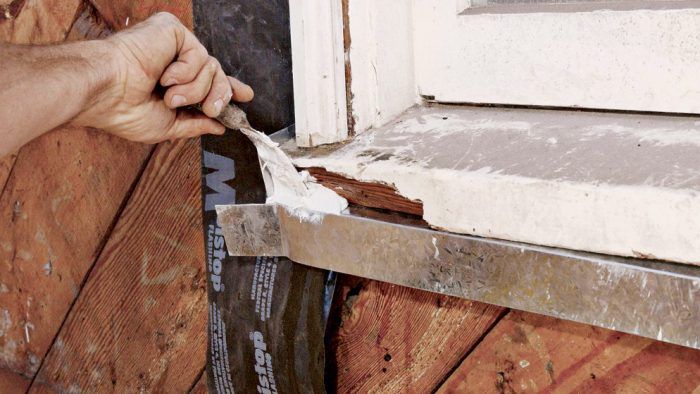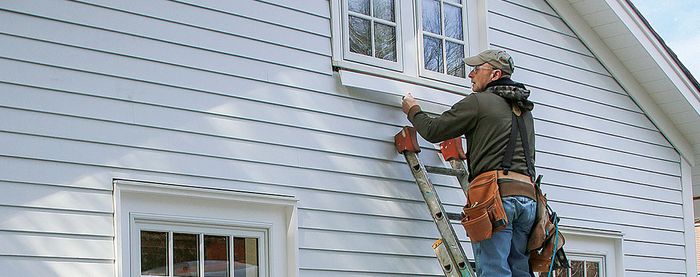Repairing Exterior Trim
Learn how to replace a rotted section of trim or make an in-place epoxy repair.

Although it may be tempting to rip out entire pieces of badly weathered or rotted exterior trim, repair is often a better option if the original trim would be difficult to remove or if replacement trim is very expensive. Before deciding, survey the extent of the rot and address the root cause. Otherwise, you’ll only be treating the symptom.
Replacing rotted sections of trim
This is a reasonable option when the bottom of an otherwise sound trim board has rotted away. Flat and square trim is easier to replace and match than molded trim. Rotted bottoms of corner boards and splashboards are usually easy to cut free and replace, whereas punky doorsills or windowsills are probably best replaced or repaired in place using epoxy, as described in the next section.
Replacing the bottom end of a rotted board is straightforward. Draw a line across the face of the board, 6 in. above the bad section. After setting your circular-saw blade to the thickness of the board, use a Speed Square to guide the saw shoe, making a 90° cut. Wear safety glasses, and use a demo blade because there may be hidden nails. The replacement piece should be the same thickness, width, and—preferably—species as the original trim. To join the new section to the old, use a biscuit joiner to cut a biscuit slot in both board ends. Dry-fit everything, prime all surfaces with epoxy primer, and allow the primer to dry well. Then glue the pieces together with epoxy. Hold the boards in place with a piece of scrap screwed to both. Give the epoxy a day to cure (or whatever the manufacturer suggests), and you’re ready to sand and paint. Alternately, you could use polyurethane glue or Titebond III wood glue as long as both pieces of wood being joined are sound.
In-place epoxy trim repairs
Epoxy wood filler is appropriate to use when the rotted area is relatively small (epoxy is expensive) and the trim would be difficult or costly to replace. Rotted windowsills or sashes, for example, are tough to remove. Plus, because epoxy putty can conform to any shape and is easily carved, using it can be a much faster and easier option than carefully cutting, fitting, and gluing pieces of wood where the piece you’re replacing is complex or unusually shaped. Epoxy applications vary considerably, so visit manufacturers’ websites (try Abatron, ConServ Epoxy, and Advanced Repair Technology, for example) for specifics or get recommendations at your local home center.
Use a chisel to dislodge loose, crumbling wood. Suck up debris with a shop vacuum. Allow the wood to dry thoroughly before proceeding. Although it’s often desirable to cut back to solid wood, soft, punky wood can be reinforced by impregnating it with liquid two-part epoxy. Typically, you’d drill a series of small-diameter holes into the wood and then inject liquid epoxy into them until the wood is clearly saturated. After the epoxy cures, the impregnated wood becomes as hard as a rock.
For the best bond, apply the puttylike filler while the consolidant is still tacky. Avoid getting epoxy on your skin, and by all means wear a respirator when applying or sanding it. After the filler dries and you’ve sanded it to its final shape, prime and paint it. Although otherwise tough, some epoxies are degraded by UV-rays, and whatever original wood remains still needs protection from the elements.
| PRO TIP: Epoxy filler can be applied with a putty knife. But the filler is easier to shape to match existing contours by hand—hands protected by latex gloves, that is. Restorationist Tom O’Brien suggests donning three or four pairs of disposable latex gloves at the start of the job and peeling them off as they become gunked up. |

Excerpted from Renovation, 5th Edition (The Taunton Press, 2019) by Michael Litchfield and Chip Harley
Available at Amazon.com.








View Comments
The article discusses epoxy ("expensive") but doesn't mention Bondo. My impression is that epoxy is stronger, harder and adheres better, while Bondo is easier to work with and cheaper. Anybody know any reason not to use Bondo in non- or semi-structural applications?